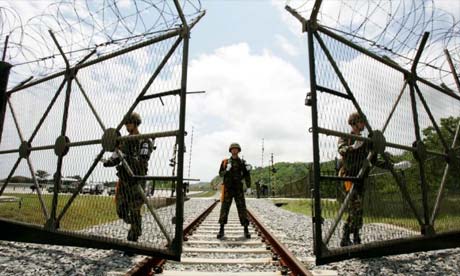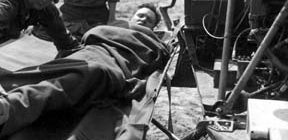Need details on the Korean DMZ war division? Learn more about the post-Korean War Demilitarized Zone or Korean DMZ…
The Korean DMZ war continues even after the armistice agreement led to a ceasefire. That is because there was no follow up peace treaty and technically this leaves North and South Korea at war till today.
The Korean DMZ or the demilitarized zone refers to that part of the territory that runs from east to west of the Korean Peninsula and approximately divides it into half.
The DMZ in Korea crosses the 38th Parallel at an angle. It is considered a buffer zone between North Korea and South Korea. On the south of the 38th Parallel you can find the west end of the DMZ, while on the north of the 38th parallel lies the east end of the DMZ.
The division is 248 km in length and stretches 4 km in width. Since 1953 till today it is considered the heaviest militarized border in the world.
Original Border North Korea and South Korea
The original boundary of the Korean Peninsula, which initially separated the south and north, was known as the 38th parallel north. It was the boundary established to separate the American and Soviet occupied areas after World War II had ended in Korea.
In 1948 North Korea and South Korea were established as two sovereign states. North Korea is formally known as the Democratic People’s Republic of Korea while South Korea is formally known as the Republic of Korea.
After their creation the 38th parallel functioned as an internationally and nationally recognized de facto border. Due to the aftermath of World War II it became one of the most sensitive locations during the entire stretch of the Cold War era.
The Korean Conflict and Korean DMZ War
The sponsor states for North Korea and South Korea were basically the Soviet Union and USA. From 1948 onwards they were heavily dependent on the sponsors until the Korean War broke out. The conflict resulted in the loss of 3 million civilians and military personnel and ended with the division of the Korean Peninsula through the Korean DMZ post war.
The invasion of South Korea by the North Korean government was sponsored by the Soviet Union and it was initiated in 1950 on June 25 and ended in 1953. The end of the Korean conflict was achieved through international intervention that pushed back the North Korean and Soviet troops behind the 38th parallel.
Armistice Treaty and Creation of Korean DMZ
There was an armistice agreement signed between both the sovereign states where North Korea agreed to push back its military forces 2200 yards from the front line to establish the 2.5 mile wide buffer zone.
The Korean DMZ War
Due to the stalemate there is a constant hostility between the two Koreas and a huge number of military personnel guard the border and there is constant potential of aggressive behavior from the North.
Under the armistice agreement there is a detailed listing of how many military personnel and the type of weaponry permitted in the DMZ and neither is allowed to cross the original military demarcation line.
There have been continual outbreaks of violence since that time and to date more than 500 South Korean soldiers along with US military personnel have been killed according to the data recorded till 1999 and a cease-fire was initiated.





